

 |
||
 |
||
Vol. 10 (1): June 2007 |
||
NMFS report warns of Hawaiian monk seal extinction
In November 2006, the National Marine Fisheries Service published its long-awaited Recovery Plan for the Hawaiian Monk Seal (Monachus schauinslandi). The plan was developed by the Hawaiian Monk Seal Recovery Team (HMSRT), whose members include current chair, Dr. Joshua Ginsberg, and Dr. Bill Gilmartin, who led efforts to draw up the last recovery plan over two decades ago. In what might be one the starkest official warnings ever voiced about the fate the species, the report states that: “The Hawaiian monk seal (Monachus schauinslandi) is in crisis: the population is in a decline that has lasted 20 years and only around 1300 monk seals remain. Modeling predicts the species’ population will fall below 1000 animals in the next five years. Like the extinct Caribbean monk seal and the critically endangered Mediterranean monk seal, the Hawaiian monk seal is headed to extinction. Actions to date have not been sufficient to result in a recovering population.”In an initial 5-year plan estimated to cost in access of $52 million, the following actions are envisaged:
The report predicts a total period of recovery for the species of 54 years, on the basis that a population can only be considered “recovered” if it continues to qualify for “threatened” classification for 20 consecutive years. The 54-year effort has been budgeted at $432,016,000. The full report, its findings and recommendations can be downloaded from the Monk Seal Library or from the NMFS website. National Marine Fisheries Service. 2006. Recovery Plan for the Hawaiian Monk Seal (Monachus schauinslandi). National Marine Fisheries Service, Silver Spring, MD: 1-148. [PDF
|
|||||||||||||||||||
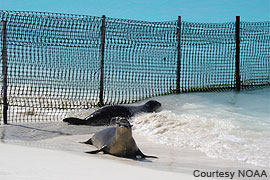 |
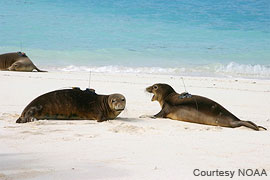 |
|
|
Captive Care pups on Midway. |
||
Elements of the Captive Care Project, which the NOAA Pacific Islands Fisheries Science Center runs in collaboration with other government agencies and NGOs such as the Marine Mammal Center, include:
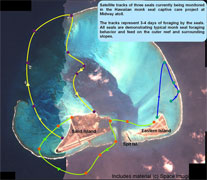 |
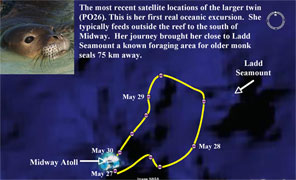 |
|
|
Samples of the satellite tracking maps (courtesy Charles Littnan). Click to enlarge. |
||
The NOAA Pacific Islands Fisheries Science Center site charts the progress of the pups, as well as providing direct public access to satellite tracking maps showing their post-release movements.
NOAA News Online (Story 2766). NOAA comes to the aid of rare monk seal twins.
NOAA. Captive Care and Release Project Seeks to Aid Recovery of the Endangered Hawaiian Monk Seal. NOAA Pacific Islands Fisheries Science Center.
The Marine Mammal Center: http://www.marinemammalcenter.org
Monk seal dies as team tries to catch it. 15 April 2007.
An endangered Hawaiian monk seal died Tuesday as a team of scientists tried to capture it to attach data instruments and conduct a health screening, officials said.
The female seal had been frequenting Hanauma Bay for several days and had a fish hook caught in its rear flipper, catching the attention of scientists from the Pacific Islands Fisheries Science Center.
Scientists tried to place a net over the seal, but it hit its head on a rock and died, said Sam Pooley, director of the Pacific Islands Fisheries Science Center.
The seal, which was about 2 to 3 years old, died from trauma to the head, a National Oceanic and Atmospheric Administration veterinarian confirmed… (Honolulu Star Bulletin)
http://starbulletin.com/2007/04/15/news/story09.html
Surf’s up for seals
Satellite tracking shows females recently released from captivity are doing well. 7 April 2007.
A half-dozen female Hawaiian monk seals at Midway Atoll could be the key to the endangered species' future.
Each of the pups, which range in age from 9 months to a year, was underweight after weaning from their mother's milk last year. But after months in captive care, bulking up on high-calorie herring and getting top-notch medical care, scientists hope that the formerly puny pups will thrive… Only one in five seals survives to reproductive age, scientists know from extensive study in the Northwestern Hawaiian Islands, where most of the seals live. The current “captive care and release project” was jump-started last May, when twins referred to as P022 and P026 by their flipper tag numbers were brought to Oahu to build them up at the NOAA Fisheries Science Center's Kewalo facility. They are the first set of twins to survive past weaning… (Diana Leone, Honolulu Star Bulletin)
http://starbulletin.com/2007/04/07/news/story01.html
Follow six monk seals in wild on Web site. 7 April 2007.
The Hawaiian monk seal population is about 1,200 worldwide, the lowest ever recorded.
Researchers have been making efforts to increase the number through a new captive care project at Midway Atoll that released six female monk seals last month.
Should efforts like these cease, researchers fear the number could drop below the key threshold of 1,000 worldwide.
"The Hawaiian monk seal population is in the worst shape it's ever been in," Robert Braun, a National Oceanic and Atmospheric Administration Fisheries contract veterinarian, said at a press conference yesterday.
Through this captive care project, monk seal scientists at the Pacific Islands Fisheries Science Center and several other partner agencies are trying to improve pup survival to increase the population growth rate.
Currently, the chance a monk seal pup has to reach reproductive age is less than 20 percent… (Catherine E. Toth, Honolulu Advertiser)
http://honoluluadvertiser.com/apps/pbcs.dll/article?AID=/20070407/NEWS11/704070330/1001/NEWS
Monk seals can be tracked on new Web site. 6 April 2007.
In response to the many requests about the status of twin Hawaiian monk seals kept in captive care and returned to Midway Atoll in October 2006, the National Oceanic and Atmospheric Administration Fisheries launched a new Web site to allow you to track the released monk seals.
People can view the location of the twins and four other Hawaiian monk seals as they venture around the three islands that make up Midway Atoll by visiting http://www.pifsc.noaa.gov/psd/captivecareproject.php - monkseal and then click the link for the seal you want to track.
Devices attached to the monk seals send information via satellite about their location and dive depths… (Catherine E. Toth, Honolulu Advertiser)
http://the.honoluluadvertiser.com/article/2007/Apr/06/br/br0528397416.html
Fatal monk seal entanglements linked to El Niño. 9 March 2007.
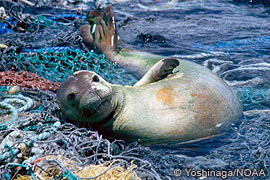 |
|
|
A juvenile monk seal risks entanglement in derelict fishing gear at Pearl & Hermes Reef in the NWHI. (Photo: Chad Yoshinaga / NOAA Pacific Islands Fisheries Science Center) |
A link between Hawaiian monk seals becoming entangled in discarded fishing gear and the global climatic phenomenon called El Niño has been revealed. The finding will help focus the cleanup efforts aimed at conserving the critically endangered animals.
The danger of getting caught up in old nets and other marine debris is seriously hindering the recovery of seal populations. The new work shows entanglement is more common in El Niño years because unusual wind and ocean currents concentrate the debris in the seals’ habitat… (Aria Pearson, New Scientist)
Laura Bush walks with wildlife. 2 March 2007.
Midway Atoll – First lady Laura Bush didn’t just look at the wildlife of the Northwestern Hawaiian Islands on her whirlwind visit here yesterday – she interacted with it.
Bush fed fish to a young endangered Hawaiian monk seal, one of six being fattened in an enclosure to increase their survival chances when re-released to the wild… (Diana Leone, Honolulu Star Bulletin)
http://starbulletin.com/2007/03/02/news/story04.html
Mrs. Bush's Remarks to the Press After Visiting the Hawaiian Monk Seal Captive Care Project. 1 March 2007. Midway Atoll.
MRS. BUSH: This is a great way to end today, with the monk seals, because so far today it's looked like this is all really bird life, but the real huge number of species, and one of the reasons this has been named a national monument, is because of the marine life – the fish that we didn't get to see today, of course, we didn't snorkel, but if you were here in the summer, you probably could do that – and all the other algae and other things that are below the water that are so important to this national marine monument.
So thanks you all for coming with me today. It's been a really terrific day.
Q (Inaudible.)
MRS. BUSH: Well, I love the monk seals, of course, everyone loves them, loves the way they look. And then I fell in love with all those little albatross chicks. You feel very protective of them, they're so vulnerable, sitting on their nests. It's so important that they don't have -- they don't have any natural predators here in their natural life, and it's really important that no invasive predators ever come.
Q What can people back home, do you think, do? What can people at home do to help ensure that these animals have a safe habitat?
MRS. BUSH: Well, I hope people will study up about the Northwestern Hawaiian Islands, about this very important part of our country and the new monument here that protects the Northwestern Hawaiian Islands.
But I also hope people will take from this that we need to really pay attention to how we recycle plastic, and to pay attention to everything that you consume at home that's plastic, and how you get rid of it, and just make sure it doesn't someday end up here on one of these islands, or on any other coast, or in the stomach of one of these marine animals. (The White House, News & Policies)
http://www.whitehouse.gov/news/releases/2007/03/20070302
Judge rules rights violated in seal beheading. 10 January 2007.
Lihue – Prosecutors will have a tough time trying to convict a Kauai man of charges he cut off the head of a dead monk seal.
District Judge Trudy Senda said yesterday that federal and state law enforcement officers violated Justin Freemon's rights last May while questioning him about the dead monk seal at Pilaa Beach on the northeast side of the Garden Isle…
Senda said the law enforcement officers should have read Freemon his Miranda rights. But they continued questioning him and eventually Freemon led them to his campsite, where he showed them the head and the knife used to cut it off. Now the knife, the head, and any other statements cannot be used at trial. (Tom Finnegan, Honolulu Star Bulletin)
http://starbulletin.com/2007/01/10/news/story11.html
A struggle to preserve a Hawaiian Archipelago and its varied wildlife. 19 December 2006.
MIDWAY ATOLL, Northwestern Hawaiian Islands Marine National Monument – As the pilot of the Coast Guard C-130 transport plane banks and circles over atoll after deserted atoll on a five-hour, 1,400-mile flight from Honolulu, the sheer emptiness of the world’s largest nature reserve becomes starkly apparent.
Yet two of the most powerful men in the world – first President Bill Clinton and then President Bush – struggled for eight years to upgrade the area into a true reserve, in a process that involved more than 100 public meetings and 52,000 public comments, most of them supportive. The main obstacle was a tiny, marginally profitable fishing fleet composed of eight boats and employing fewer than 20 people, most of them part-time, but vigorously defended by a powerful senator and an entrenched federal bureaucracy. (Christopher Pala, New York Times)
http://www.nytimes.com/2006/12/19/science/earth/19hawa.html?_r=1&ref=us&oref=slogin
Seals’ meals revealed
A study reveals seals' meals as part of the ongoing effort to save the scarce mammals. 30 November 2006.
New information about what Hawaiian monk seals eat could help wildlife managers in their quest to save the species from extinction, federal scientists said yesterday.
Tiny blubber samples taken from 248 healthy seals over the past eight years have been analyzed to determine that the endangered animals' most frequently eaten prey are:
The gindai, boar fish and duckbill fish, and some of the squid, live at depths of 600 feet or more, said study participant Charles Littnan, an ecologist with the Pacific Islands Fisheries Science Center.
That is significant because "I don't think anybody knew before now that deep-water species of fish were as large a component of the monk seals' diet as they appear to be," Bill Robinson, regional administrator for the National Oceanic and Atmospheric Administration Regional Office, said yesterday after hearing a presentation on the research…
"The new data seems to show that lobsters don't seem to be a part of the monk seals' diet over the last six to eight years," Robinson said. But whether they ate them frequently when they were more abundant might never be known, he said… (Diana Leone, Honolulu Star Bulletin)
http://starbulletin.com/2006/11/30/news/story04.html
New rules help ensure that we will have fish in the future. 21 November 2006.
The [gillnet fishing] regulations became necessary after the introduction of cheaply manufactured monofilament lay gillnets that spurred a destructive force not seen when nets made by hand were valued possessions. Irresponsible fishers stretched their nets over wide areas and left them for long periods of time. The nets trapped everything that swam into them, killing desirable and unwanted sea life indiscriminately. Moreover, the nets often were abandoned, damaging coral reefs and entangling endangered species like the young monk seal found dead off Waimanalo last month, wrapped in a gillnet… (Editorial, Honolulu Star Bulletin)
http://starbulletin.com/2006/11/21/editorial/editorial01.html
Panel lays down gillnet regulations
DLNR will curtail "curtains of death," as critics call them. 18 November 2006.
Lay gillnet fishing will be prohibited around Maui and portions of Oahu's coast, a state board decided yesterday.
Where permitted, the nets cannot be used at night or left in place longer than four hours, and they must be checked every 30 minutes for air-breathing animals such as sea turtles and Hawaiian monk seals, according to new Board of Land and Natural Resources rules approved yesterday.
Gillnets also must not be longer than 125 feet and must have owner identification tags and buoys to help conservation enforcement officers catch offenders…
Detractors of the [fishing] method have referred to it as "a curtain of death" and have pointed to the recent tangling death of an endangered Hawaiian monk seal pup in a gillnet off Waimanalo as a demonstration of the nickname. (Diana Leone, Honolulu Star Bulletin)
http://starbulletin.com/2006/11/18/news/story09.html
Gill nets catch flak after seal death
The pup's demise is cited as another reason for regulation. 8 November 2006.
The recent death of an endangered Hawaiian monk seal pup provides evidence to support the state's push to regulate gill net fishing and debunks arguments that larger animals can escape them, a state Department of Land and Natural Resources official says.
The 5-month-old seal was found tangled in a gill net near Waimanalo last month along with a small white tip shark and other fish.
“This really reinforces the idea that gill nets can be destructive and can kill endangered species,” said Peter Young, department director… (Honolulu Star Bulletin)
http://starbulletin.com/2006/11/08/news/story16.html
Seal’s death shows need for gillnet rules. 24 October 2006.
On the same day that twin Hawaiian monk seals, carefully nursed to health, were returned to their isle of birth at Midway, another of its breed was found dead, its body snarled in a gillnet offshore of Waimanalo.
The death of the 5-month-old pup underscores the need to restrict the use of lay gillnets that kill indiscriminately when left unattended by irresponsible fishers. The state, which has proposed but has yet to finalize gillnet rules, should move ahead quickly.
The pup, dubbed Penelope, the first born on Oahu in eight years, is certainly not the only sea creature to have been harmed by the nets. The cheap monofilament webs trap everything that swims into them, including endangered species like turtles and monk seals. Weighted at the bottom, they also damage coral reefs, breaking off pieces or scraping them. (Editorial, Honolulu Star Bulletin)
http://starbulletin.com/2006/10/24/editorial/editorial02.html
EndQuoteAn endangered seal on every lawn One of the chief concerns for environmentalists over the proposed La‘au development is over what will become of the Monk Seal population, which regularly comes to feed and spawn on the shores at La‘au Point. What MPL [Molokai Properties Limited] is implying, in their press release, is that not only will a millionaires’ subdivision seamlessly fit into the Monk Seal’s feeding and breeding habits, it will actually improve both. MPL seems to envision a zoological utopia where man and seal live together in gentle harmony – man helping the seals’ food supply and the seals in turn, fertilizing their lawns.
|
Copyright © 2007 The Monachus Guardian. All Rights Reserved |